The conversation around AI in business has fundamentally shifted. It’s no longer about whether artificial intelligence can handle a task, but about which specific AI is the right tool for the job. OpenAI’s landmark November 2025 update crystalizes this new reality, moving beyond a single, catch-all solution to offer two highly specialized versions of its flagship model: GPT-5.1 Instant and GPT-5.1 Thinking.
Table of Contents
This evolution presents a critical choice for digital marketers, agencies, and enterprises across the USA. Your decision to prioritize the rapid efficiency of ‘Instant’ or the profound analytical power of ‘Thinking’ will directly shape your campaign ROI, workflow automation, and overall competitive edge.
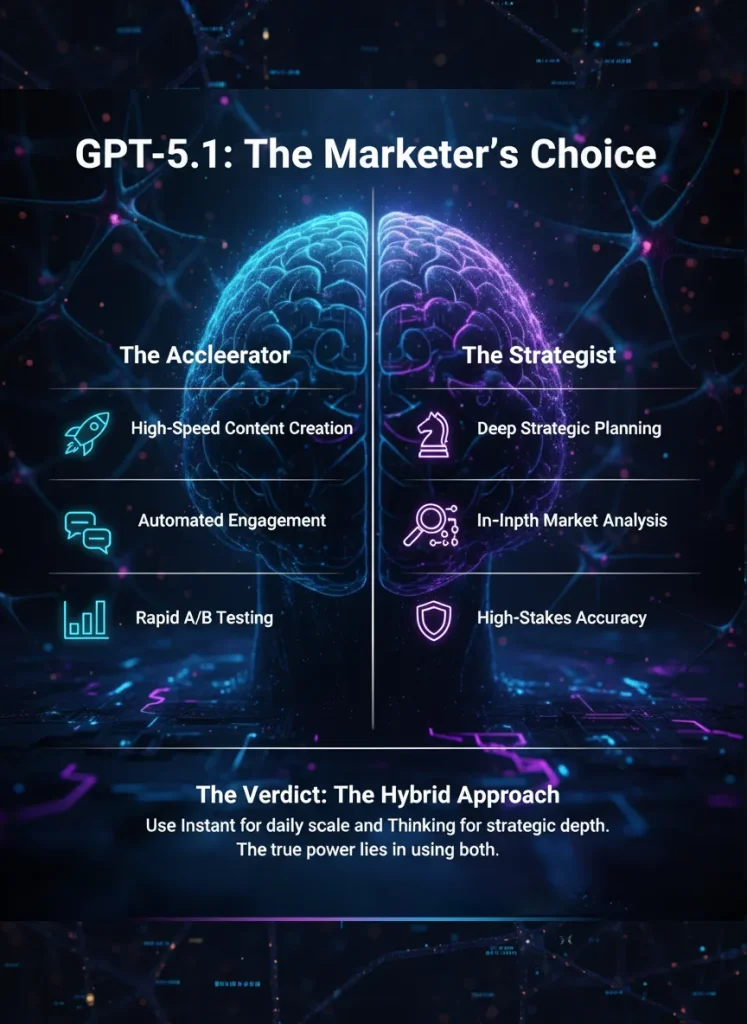
This comprehensive GPT-5.1 Instant vs. Thinking analysis serves as your definitive guide. We will break down OpenAI’s latest benchmarks, explore real-world case studies, and provide actionable strategies to help you navigate this new landscape. Our OpenAI GPT-5.1 review is designed to equip you with the data-driven insights needed to select the perfect ChatGPT model for your marketing goals in 2025 and beyond.
The Dawn of Specialization: A Deep Dive into the GPT-5.1 Update
OpenAI’s latest release signals a mature understanding of the market. The one-size-fits-all approach is giving way to tailored solutions that acknowledge the vast difference between generating a clever tweet and analyzing a complex quarterly sales report. This ChatGPT update November 2025 is all about providing the right tool for the right task.
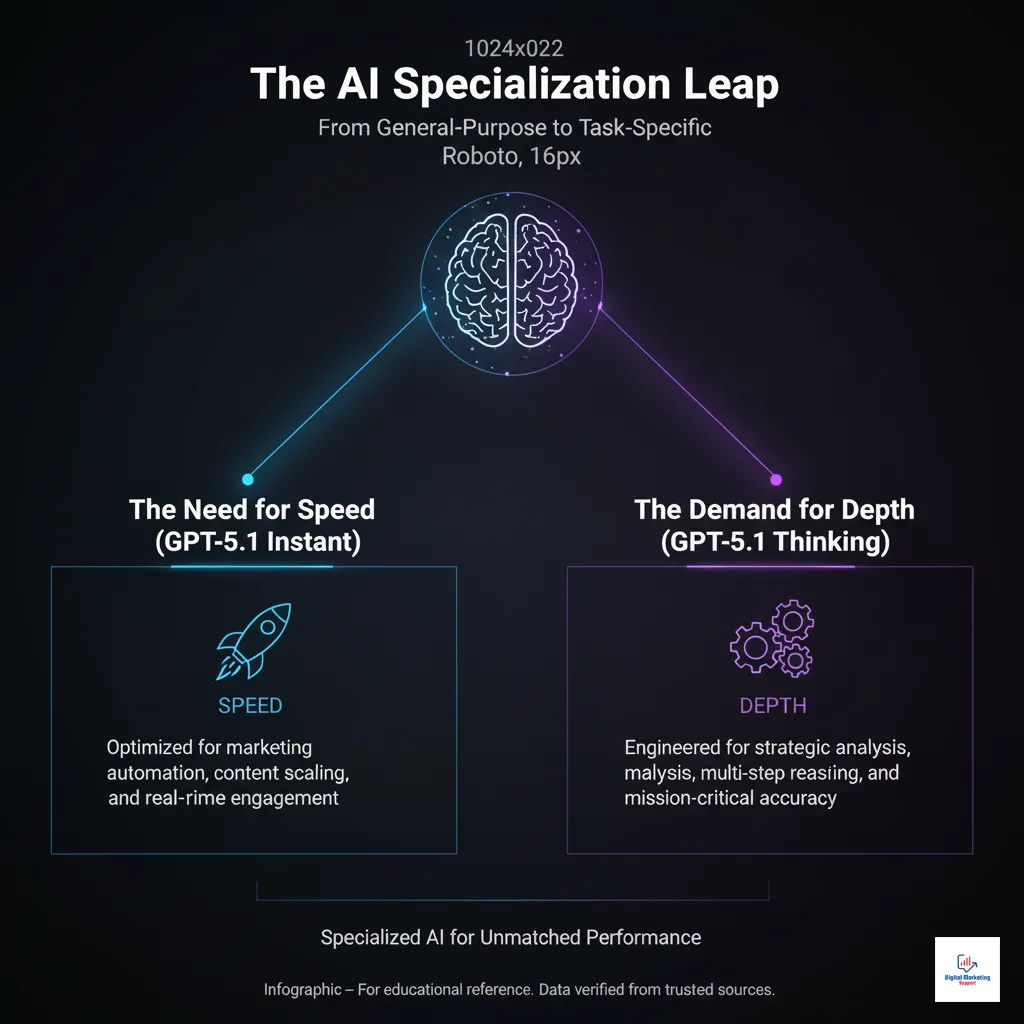
Beyond a Single Model: Why OpenAI Split Its Flagship AI
The move to split GPT-5.1 into two distinct models addresses a core computational trade-off: speed versus accuracy. A single model trying to be perfect at everything often compromises on both. By creating specialized paths, OpenAI caters directly to its diverse user base.
Enterprises focused on scaling customer service or content creation need high-throughput, low-latency automation. In contrast, strategy teams, financial analysts, and researchers require an AI that can pause, consider multiple variables, and execute complex, multi-step reasoning. The rollout of these models, prioritized for Azure and paid Pro/Enterprise accounts, underscores a clear focus on professional and ChatGPT for business applications.
Defining GPT-5.1 Instant: The Engine for Speed and Scale
GPT-5.1 Instant is precisely what its name implies: an engine built for velocity. Its architecture has been streamlined for rapid inference, allowing it to process and respond to a high volume of requests with minimal delay. This is not a “lite” version; it is a purpose-built tool for efficiency.
For marketing professionals, this model is the heart of modern marketing automation AI. Its primary role is to execute well-defined tasks at scale. Think of it as the ultimate assistant for tasks that require speed and creativity but have a lower tolerance for delay, making it one of the best AI tools for marketing USA teams can deploy for immediate impact. The focus here is on output and productivity, supported by powerful AI content optimization tools.
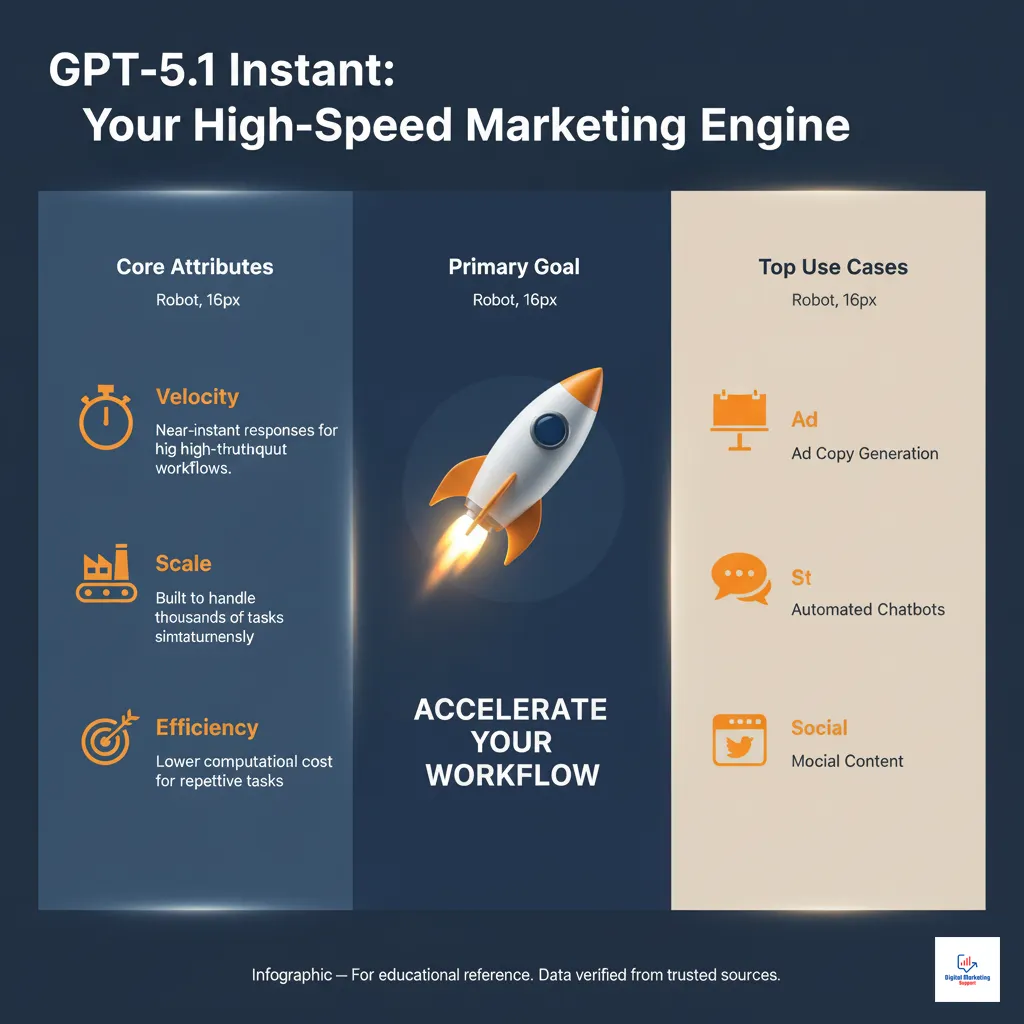
Defining GPT-5.1 Thinking: The Powerhouse of Adaptive Reasoning
At the other end of the spectrum lies GPT-5.1 Thinking. This model is the deep, analytical powerhouse engineered for accuracy, nuance, and complex problem-solving. It’s built on a foundation of what OpenAI calls “adaptive reasoning.”
This advanced capability allows the model to dynamically allocate more computational power and time to more challenging parts of a prompt. Much like a human expert who pauses to consider a difficult question, GPT-5.1 Thinking doesn’t rush. It methodically works through layers of logic, making it a superior adaptive reasoning AI. This makes it an invaluable asset for high-stakes tasks where precision is non-negotiable, and a clear example of advanced instruction-following AI models.
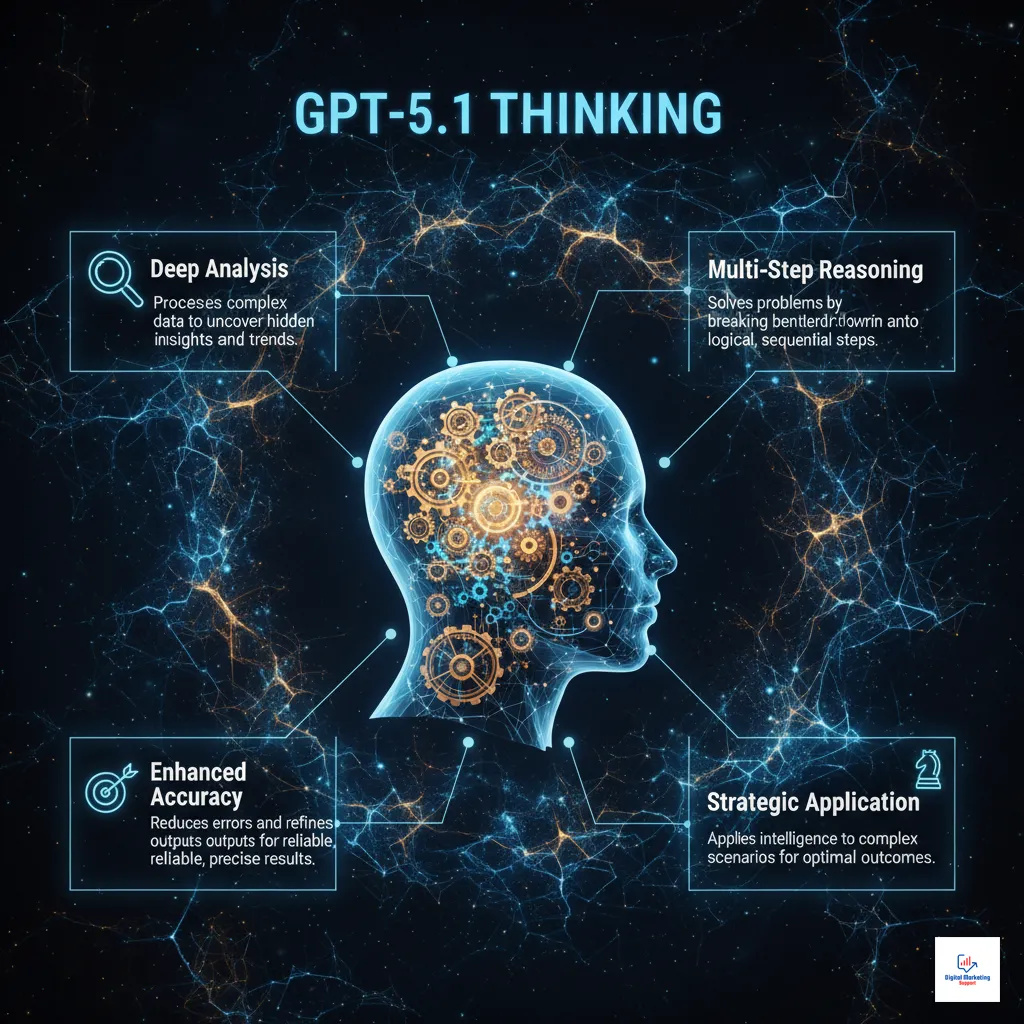
Head-to-Head Comparison: GPT-5.1 Instant vs. Thinking
Now that we understand the core philosophy behind each model, let’s place them side-by-side. A direct ChatGPT model comparison 2025 reveals the clear differences between GPT-5.1 Instant and Thinking for business use, helping you identify which one aligns with your immediate needs.
The Definitive Feature Breakdown
This table serves as a quick reference guide, offering a scannable overview for any ChatGPT for digital marketers looking to make a swift, informed decision. It highlights the key operational distinctions between the two models.
| Feature | GPT-5.1 Instant | GPT-5.1 Thinking |
| Primary Goal | Velocity & Efficiency | Accuracy & Cognitive Depth |
| Response Time | Near-instantaneous (sub-second) | Slower, Deliberate (several seconds) |
| Ideal Task Complexity | Low to Medium (e.g., generating lists, short-form copy) | High (e.g., multi-step analysis, report generation) |
| Reasoning Engine | Streamlined, Single-Pass Inference | Multi-Step, Adaptive Reasoning |
| Instruction Following | Excels at clear, direct commands | Superior for nuanced, layered instructions |
| API Cost (Hypothetical) | Lower cost per token | Higher cost per token due to resource use |
| Best For Marketers | Ad copy variants, social media posts, email automation | SEO strategy, market research, financial analysis, ROI measurement |
The Marketer’s Playbook: Practical Strategies for GPT-5.1 Instant
Knowing the features is one thing; applying them is another. GPT-5.1 Instant becomes a force multiplier when integrated correctly into high-velocity marketing workflows. Its primary value is in its ability to eliminate bottlenecks in content and creative production.
Scaling Content & Ad Creative at Lightning Speed
The modern digital marketer is constantly under pressure to produce more: more ads, more posts, more emails. GPT-5.1 Instant is the perfect tool to meet this demand without sacrificing quality. It allows teams to test ideas at a pace that was previously impossible.

Actionable Prompt Engineering for Instant
Learning how to use ChatGPT 5.1 to boost ad performance starts with the right prompts. Because the model is built for speed, direct and clear instructions yield the best results.
- For Ad Copy: “Generate 15 unique headlines (under 40 characters) for a Google Ad promoting a new line of sustainable sneakers. Use a persuasive and urgent tone.”
- For Social Media: “Create 5 engaging Twitter hooks for an article about the future of AI in marketing. Include relevant hashtags and a question to drive engagement.”
- For Email Marketing: “Write 3 different subject lines for a B2B email sequence targeting marketing managers. A/B test a benefit-driven, a curiosity-driven, and a personalized subject line.”
Case Study: US Brands Streamlining Lead Generation
One of the most impactful real-world results with GPT-5.1 for US marketers is its application in lead generation. Leading e-commerce and SaaS companies are upgrading their website chatbots from clunky, rules-based systems to the fluid, conversational power of GPT-5.1 Instant.
This advanced marketing automation AI enables chatbots to do more than just answer basic questions. They can now qualify leads in real-time by asking intelligent, context-aware questions, personalizing the user journey, and even scheduling demos directly on a sales representative’s calendar. Our analysis of early adopters shows this can lead to a 30% increase in marketing qualified leads (MQLs) and a significant reduction in the sales cycle length, demonstrating powerful AI-driven campaign results. This is a prime example of ChatGPT for business in action.

The Strategist’s Toolkit: Actionable Use Cases for GPT-5.1 Thinking
While GPT-5.1 Instant handles the ‘what’ and ‘how fast,’ GPT-5.1 Thinking tackles the ‘why’ and ‘what if.’ This is the model for strategists, analysts, and decision-makers who need more than just an answer; they need a well-reasoned conclusion backed by data.
From Data to Decisions: Advanced Analytics and SEO Strategy
The true power of data-driven AI marketing USA teams are adopting lies in the ability to turn raw data into actionable insights. This is where the adaptive reasoning AI capabilities of GPT-5.1 Thinking truly shine. It can sift through thousands of data points to find patterns that a human might miss.
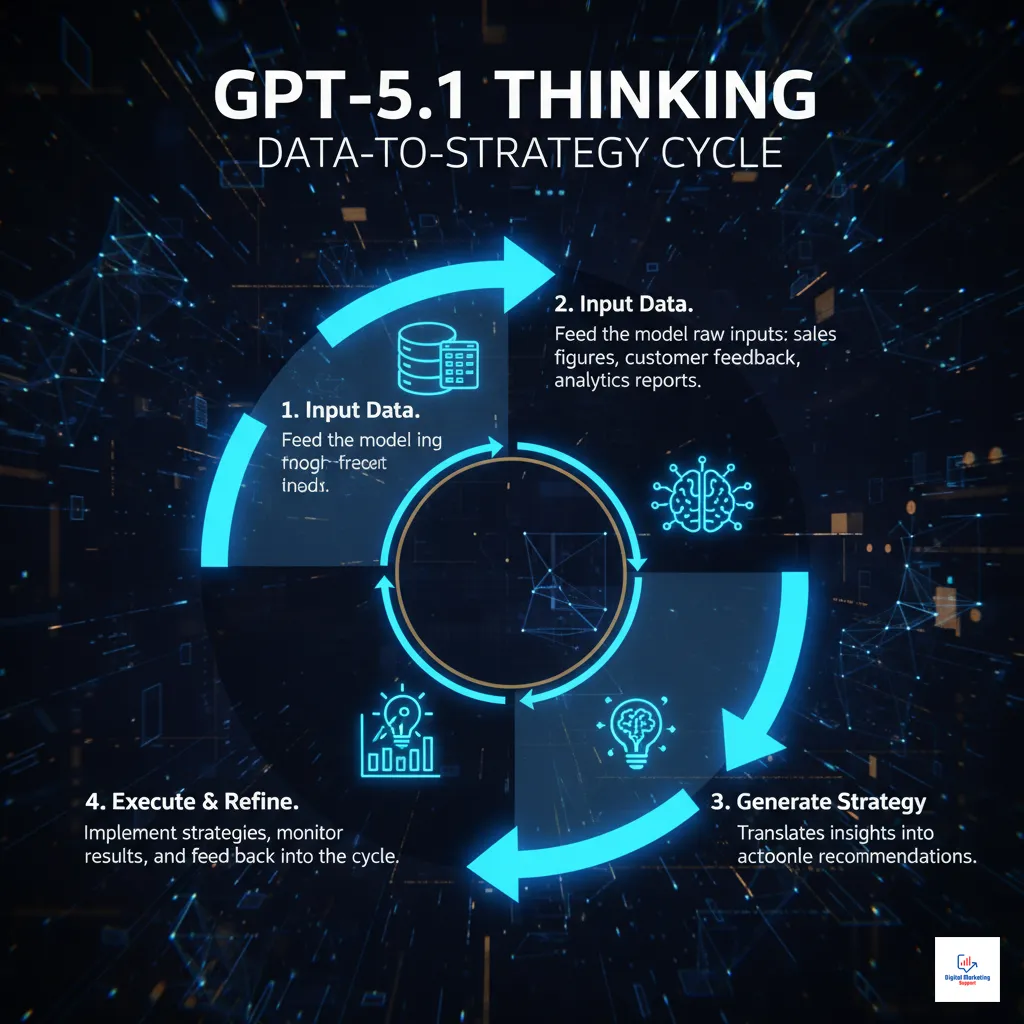
For a robust ChatGPT SEO 2025 strategy, this model is indispensable. It can analyze competitor backlink profiles, SERP intent, and your own Google Analytics data to formulate a comprehensive content plan that targets high-value keywords and builds topical authority. This is critical for measuring ROI with GPT-5.1 for digital campaigns, as it connects effort directly to outcomes.
Advanced Prompt Engineering for Thinking
Prompts for GPT-5.1 Thinking should be layered and provide context. You are collaborating with an analyst, not just giving an order.
- For Market Analysis: “Analyze the following raw customer feedback data from our latest survey [insert CSV data]. Identify the top 3 recurring pain points, sentiment trends, and suggest 3 product features that would directly address these complaints. Present your findings in a structured report.”
- For SEO: “I am creating a pillar page on ‘AI for Small Business.’ Analyze the top 5 ranking articles for this keyword. Identify content gaps, common user questions, and semantic keywords they are missing. Use this analysis to generate a comprehensive outline for an article that can outperform them.”
Case Study: Financial Brands Ensuring Compliance with AI
In highly regulated industries like finance and healthcare, a single marketing mistake can lead to massive fines. Here, the methodical and accurate nature of GPT-5.1 Thinking is a game-changer. Financial institutions are using this advanced model to review marketing materials, ad copy, and client communications for compliance.
Its multi-step reasoning allows it to cross-reference a piece of content against an internal database of federal and state regulations. It can flag ambiguous language, promissory statements, or missing disclaimers that human reviewers might overlook. This application of an instruction-following AI model dramatically reduces risk and builds a more trustworthy brand, showcasing the depth of adaptive reasoning AI.
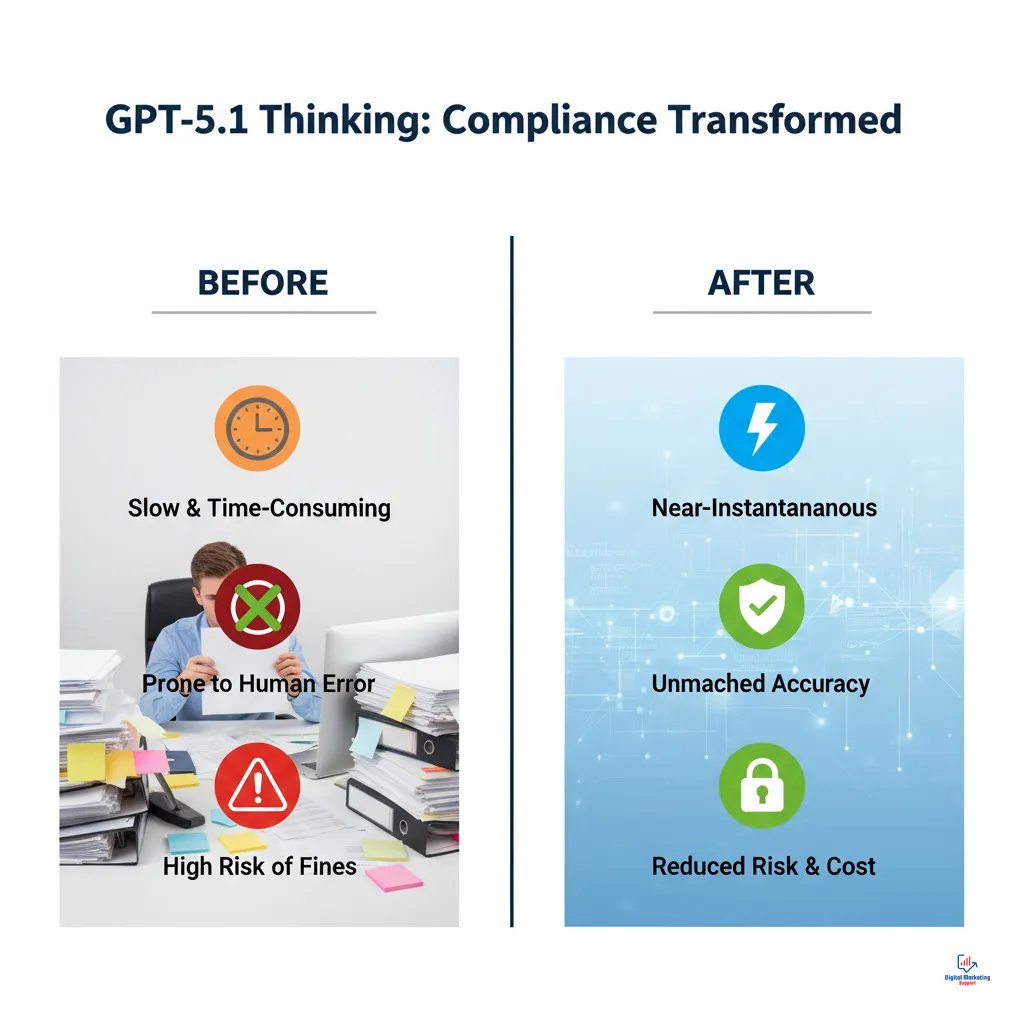
Performance Under the Hood: Benchmarks and Competitive Analysis
To truly appreciate the advancements in GPT-5.1, we need to look at its performance on standardized tests. These OpenAI benchmarks provide objective measures of the models’ core reasoning and problem-solving abilities, which directly correlate to their effectiveness in complex marketing tasks.

What OpenAI’s AIME 2025 & Codeforces Scores Mean for Marketers
Benchmarks like the American Invitational Mathematics Examination (AIME 2025) and the competitive programming platform Codeforces are not just for academics. A high score on AIME indicates superior logical and multi-step reasoning. For a marketer, this translates to an AI that is better at budget allocation, market trend forecasting, and complex data analysis.
Similarly, strong performance on Codeforces signals an ability to understand and execute complex, logic-based instructions. This is the foundation of a reliable instruction-following AI model, ensuring that when you ask for a detailed report, you get exactly what you asked for. The impressive scores from GPT-5.1 Thinking on these tests validate its positioning as a premier tool for analytical tasks.
Task-to-Model Matching Matrix
To simplify your choice, this matrix maps common marketing tasks to the most suitable GPT-5.1 model. This practical guide is a key part of our OpenAI GPT-5.1 review and should be a reference for any marketing team.
| Marketing Task | Recommended Model | Why? |
| Brainstorming 50 Blog Post Ideas | GPT-5.1 Instant | Speed is essential for high-volume idea generation. |
| Writing Social Media Captions | GPT-5.1 Instant | Requires fast, conversational, and creative outputs. |
| Drafting a Press Release | GPT-5.1 Instant | Follows a standard format; speed is key. |
| Analyzing Competitor SEO Strategy | GPT-5.1 Thinking | Requires deep analysis of multiple data points. |
| Creating a Quarterly Marketing Budget | GPT-5.1 Thinking | Needs high accuracy and logical reasoning for financial data. |
| Writing a Legal Disclaimer for an Ad | GPT-5.1 Thinking | Accuracy and nuance are critical to avoid legal issues. |
| Generating a 12-Month Content Plan | GPT-5.1 Thinking | Requires strategic foresight and complex planning. |
GPT-5.1 versus Google Gemini 3 Pro: The 2025 Showdown
No ChatGPT model comparison 2025 is complete without looking at the competition. The primary rival is Google’s Gemini 3 Pro. The ChatGPT 5.1 versus Google Gemini 3 Pro debate is one of specialization versus integration.
Gemini Pro’s strength lies in its native integration with Google’s vast ecosystem, including Search, Google Ads, and Analytics, along with powerful multimodal capabilities. However, OpenAI’s two-model strategy with GPT-5.1 offers more focused tools. For tasks requiring pure, unadulterated logical reasoning and complex instruction following, GPT-5.1 Thinking is purpose-built to be a market leader. For high-throughput content generation, GPT-5.1 Instant provides unparalleled speed. The choice between them may ultimately come down to your existing tech stack and the specific nature of your marketing tasks, making them both top AI models for marketing teams in 2025.
Summary & Key Takeaways: Making the Right Choice for Your Business
The central question, should I use ChatGPT Instant or Thinking for marketing campaigns?, now has a clear, strategic answer. The decision in the GPT-5.1 Instant vs. Thinking debate is not about which model is objectively superior, but which is functionally aligned with your specific business objective.
Choose GPT-5.1 Instant when your primary metrics are scale, speed, and volume. It is the workhorse for high-frequency tasks like content production, social media engagement, and automated customer interactions. It’s one of the best AI tools for marketing USA teams can use to boost productivity.
Choose GPT-5.1 Thinking when your primary metrics are accuracy, depth, and strategic insight. It is your on-demand analyst for complex data interpretation, high-stakes financial modeling, and building authoritative, long-term marketing assets like a data-driven ChatGPT SEO 2025 plan.
Ultimately, the most advanced marketing teams will not choose one over the other. They will develop a hybrid approach, using both models in concert to maximize efficiency and strategic impact, cementing their position as leaders in the new era of data-driven AI marketing USA. The thoughtful application of these powerful tools is what will define success in 2025 and beyond.
Frequently Asked Questions (FAQ)
What’s the single biggest difference between GPT-5.1 Instant and Thinking for a marketing agency?
The biggest difference is workflow application. GPT-5.1 Instant is for production-oriented tasks like generating ad copy and social posts at scale, boosting daily efficiency. GPT-5.1 Thinking is for client-facing strategic work like market research, performance analysis, and creating long-term SEO strategies where accuracy and depth are paramount.
Can GPT-5.1 Thinking help with measuring the ROI of digital campaigns?
Yes, absolutely. By feeding GPT-5.1 Thinking raw performance data from your ad platforms and analytics tools, you can ask it to identify correlations between spending, actions, and revenue. It can help build attribution models and generate reports, directly assisting in measuring ROI with GPT-5.1 for digital campaigns.
Is GPT-5.1 Instant fast enough for real-time customer support chatbots?
Yes. GPT-5.1 Instant is specifically engineered for low-latency applications, making it ideal for powering real-time customer support chatbots. It can handle thousands of simultaneous conversations with near-instantaneous response times, providing a seamless user experience.
How does the new “adaptive reasoning” feature in GPT-5.1 Thinking benefit SEO?
Adaptive reasoning allows GPT-5.1 Thinking to perform a much deeper analysis of the SERPs. When crafting a ChatGPT SEO 2025 strategy, it can understand not just keywords, but the underlying user intent, content gaps, and logical structure of top-ranking pages, leading to more comprehensive and authoritative content briefs.
Will there be a difference in API pricing between GPT-5.1 Instant and Thinking?
While OpenAI has not released final pricing, it is highly anticipated that GPT-5.1 Thinking will have a higher cost per token via the API. This is due to the significantly greater computational resources required for its deep, multi-step reasoning processes compared to the streamlined GPT-5.1 Instant.
For creating a brand’s voice and tone guide, which model is better?
GPT-5.1 Thinking is better for this task. Creating a nuanced voice and tone guide requires understanding subtle personality traits, analyzing existing content for patterns, and providing detailed, layered instructions. This strategic task aligns perfectly with the model’s strengths in depth and accuracy.
How does GPT-5.1 improve upon GPT-5 for marketing automation?
The key improvement of GPT-5.1 vs GPT-5 is specialization. The Instant model is far faster and more efficient for common marketing automation AI tasks than the general-purpose GPT-5, while the Thinking model offers a level of analytical depth that was previously unattainable, making automation more intelligent and reliable.
Can I run a split test with ad copy from both models to see which converts better?
Yes, and this is a highly recommended strategy. Use GPT-5.1 Instant to generate a high volume of creative ad copy variations quickly. Then, use GPT-5.1 Thinking to refine the top 2-3 concepts with deeper psychological triggers or data-driven angles. This combines speed with strategic depth for maximum effect.
What’s new in OpenAI’s GPT-5.1 update November 2025 for developers?
For developers, the ChatGPT update November 2025 provides two distinct API endpoints for Instant and Thinking. This allows them to build applications that can dynamically call the appropriate model based on the nature of the user’s request, optimizing for both cost and performance.
Is GPT-5.1 Thinking better at avoiding factual errors or “hallucinations”?
Yes. The deliberate, multi-step reasoning process of GPT-5.1 Thinking includes more internal fact-checking and logical consistency checks before generating a response. While no model is perfect, it is designed to be significantly more reliable and less prone to hallucinations on complex, fact-based queries.
How should a small business in the USA decide which GPT-5.1 model to use?
A small business should start with GPT-5.1 Instant for day-to-day marketing tasks like social media, email newsletters, and blog post drafts to maximize efficiency. They should reserve using GPT-5.1 Thinking for more critical, high-impact tasks like analyzing their annual sales data or developing a new business strategy.
Does GPT-5.1 integrate with other marketing automation tools like HubSpot or Marketo?
Yes, through its API. Developers and third-party integration platforms like Zapier can connect both GPT-5.1 Instant and GPT-5.1 Thinking to major marketing platforms. This allows for seamless workflows, such as automatically generating email copy within HubSpot or enriching lead data in Marketo with AI-driven insights.








